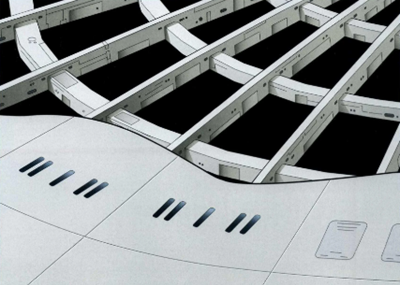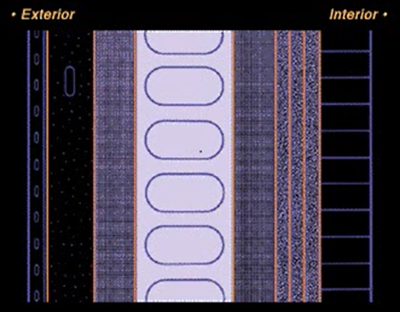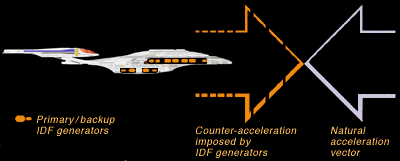Spacecraft Structure
Created by Commodore Wilkan Targaryen on Tue Dec 24th, 2024 @ 6:03pm
Hull
 The Hull and Skeletal Structure are the largest component parts of the Enterprise and provide the frame of the ship. Perhaps the most important part of the vessel itself, the Hull houses all shipboard systems and protects the crew from being exposed to space. Comprising two sections, the outer and the inner hull, Starfleet hulls and skeletal structures are built from a variety of minerals including Duranium, Duritanium Polyalloy, Polyduranium, Titranium, and Tetraburnium.
The Hull and Skeletal Structure are the largest component parts of the Enterprise and provide the frame of the ship. Perhaps the most important part of the vessel itself, the Hull houses all shipboard systems and protects the crew from being exposed to space. Comprising two sections, the outer and the inner hull, Starfleet hulls and skeletal structures are built from a variety of minerals including Duranium, Duritanium Polyalloy, Polyduranium, Titranium, and Tetraburnium.The hull of a starship provides many benefits to its crew aside from protecting them from the vacuum of space. As needed, a crew can run an energy charge through the hull in order to change its hull polarity. Originating on vessels as early as the 22nd Century, by changing hull polarity a ship can overcome some effects of attack from an enemy vessel to protect the ship's crew. Repolarization of the hull can also be useful in breaking a Tractor Beam's lock upon the vessel, or it can be used to confuse the sensors of an opponent. Additionally, some subspace instabilities can be overcome through hull polarization.
If a ship's hull is directly damaged it is possible that the structure will breach, creating a hull in the hull. Dependent upon the amount of damage caused to determine its size, when a breach occurs several emergency protocols quickly engage as the ship's atmosphere becomes exposed to the vacuum of space and the crew are at risk of being pulled out of the ship and killed. Interior bulkheads and blast doors automatically seal and the Structural Integrity Field attempts to isolate the breach to maintain overall hull integrity. Depending upon the amount of damaged caused by a hull breach, the Enterprise may have to withdraw to a nearby friendly port for repairs.
While most Starfleet vessels are not designed for atmospheric operations, members of the Century Class have been specially constructed for travel within a planet's atmosphere. The hull of the Enterprise has been outfitted with reinforced structures allowing the ship to complete movement in an atmosphere, overcoming the risks caused by the gravimetric shear and other factors of a planetary atmosphere. This is an essential resource in allowing the Enterprise to land on a planetary surface and then successfully return to space afterward.
Outer Hull and Primary Skeletal Structure
 Also known as the exterior hull, the outer hull of the Starship Enterprise consists of alloy plating connected to the trusses of the ship's primary skeletal structure via Duranium pins that are gamma-welded together. Throughout the outer hull are a series of power conduits and grid that support the Enterprise's systems and also include a specialized thermal insulation that helps the ship to resist radiation and thermal energy.
Also known as the exterior hull, the outer hull of the Starship Enterprise consists of alloy plating connected to the trusses of the ship's primary skeletal structure via Duranium pins that are gamma-welded together. Throughout the outer hull are a series of power conduits and grid that support the Enterprise's systems and also include a specialized thermal insulation that helps the ship to resist radiation and thermal energy.
Inner Hull and Secondary Skeletal Structure
Also known as the interior hull, the inner hull of the Enterprise is attached to the secondary skeletal structure of the vessel. Portions of the inner hull and its skeletal framework can be isolated from the outer hull for maintenance and expansion as needed. This is delicate work, however, as the inner hull of the Enterprise supports the power conduits and attachment points for the ship's systems.
Coordinate System
In many respects Federation Starships are small cities that are traveling through deep space. Because of their size and complexity, traversing a vessel the size of the Starship Enterprise would be next to impossible without a location system. To accommodate navigating about a starship, Starfleet Command developed an internal and external coordinate system to allow personnel and visitors to easily locate a destination aboard a starship, even one they have not previously visited. Each room aboard a starship, no matter how small, is identified by a labelled door that indicates its deck location, room number, and its sector and compartment in the internal coordinate system, and by a numerical indicator of how many centimeters it is from predefined zero points.
Reactive Armor
Designed as part of Starfleet's response to the Borg threat after the Battle of Wolf 359, Ablative Armor was designed to absorb damage by distributing the energy around the ship then, should energy exceed the conductive capacity, it would boil off from the damage. Left unchanged until the 2430s, Ablative Armor was reevaluated by Starfleet Tactical following the Vaadwaur attacks of 2435. While it had remained effective for decades, the existing Ablative Armor was quickly overwhelmed by modern weaponry. This led Starfleet Command to order the development of a new form of Ablative Armor.Known as Reactive Armor, this upgraded form of Ablative Armor consists of an outer Duranium plate covering the inert Ablative material that rests atop the Enterprise's hull. When struck by an enemy weapon, some of the energy is dissipated into the inert liner layer and distributed around the hull via its initial radiative/conducting components. The resulting pressure causes a localized bending of the plates in the area of the impact, increasing the effective thickness of the armor. Subsequent attacks in the same area will gradually weaken the Reactive Armor until the plates and inert material dissipate, but the vessel's hull will have remained intact. Rebuilding or replacing the armor requires the facilities of a starbase, space station, or similar installation.
Structural Integrity Field
The Structural Integrity Field is a specialized forcefield system that protects the ship's hull from collapsing under the effects of gross structural compression (also known as hull stress). Managed by the Structural Integrity Grid, the Structural Integrity Field helps the Enterprise to compensate from the stresses that the ship encounters on a daily basis in deep space. In layman's terms, the Structural Integrity Field holds the ship together and may be extended to help a nearby vessel that has lost its Structural Integrity Field.Similar in many ways to the Enterprise's Deflector Shield Grid, the protection provided by the Structural Integrity Field is not degraded by attacks, but it only protects the ship against pressure, stress, and similar threats to its structural integrity. If the ship encounters particularly strong or intense stresses the Structural Integrity Fields may become overwhelmed and lose effectiveness. Should the Enterprise lose its Deflector Shields entirely it is possible to reconfigure the Structural Integrity Field into a makeshift Deflector, but this jury-rigged Shield can only protect a particular system or area from attack because of its limited size.
Due to its critical importance to the ship's safety, a backup generator system has been installed for use when the primary generators are unavailable. The backup system will automatically engage once the primary system fails; nonetheless, the backup system is only effective for around 24 hours before failure. If the crew are unable to repair the primary Structural Integrity Field in that time the starship will be unable to engage its engines without causing devastating damage to the ship due to hull stress. The loss of the Structural Integrity Field also prevents the ship from sealing any hull breaches, exposing the ship's interior and personnel to the outside environment if breached.
Inertial Dampening Field
 The Inertial Dampening Field aboard a starship is used to overcome the stress on life-forms caused by the acceleration and deceleration of the vessel and prevents injury to the crew. Created in the early days of space travels, the Inertial Dampening Field is really multiple variable-symmetry force fields designed to absorb and counter the intense forces generated by high-speed travel. When normally operating, the crew feels little, if anything, when the ship accelerates, decelerates, or engages in maneuvers.
The Inertial Dampening Field aboard a starship is used to overcome the stress on life-forms caused by the acceleration and deceleration of the vessel and prevents injury to the crew. Created in the early days of space travels, the Inertial Dampening Field is really multiple variable-symmetry force fields designed to absorb and counter the intense forces generated by high-speed travel. When normally operating, the crew feels little, if anything, when the ship accelerates, decelerates, or engages in maneuvers.While Inertial Dampening Field processes are highly automated to prevent disruption, the fields can be recalibrated and redistributed manually from the Bridge. Rated by strength, at normal operation the Inertial Dampening Field is sufficient to protect its ship’s occupants from any movement-related stress created by the starship itself. Should the vessel be impacted and suffer from an atypical form of movement-related stress, the Inertial Dampening Field will analyze and compensate to protect the ship's occupants automatically. Additionally, the Enterprise can extend its Inertial Dampening Field to protect another ship which has lost its Inertial Dampening Field in an emergency.
Starfleet protocols require all of its vessels to have multiple Inertial Dampening Field generators as well as backup generators available to ensure the safety of the ship and crew, which automatically come online if the primary fields go offline. If both the primary and backup generators fail, safety protocols will prevent the Enterprise from engaging its Impulse and Warp Drives until repairs can be completed as everyone on the ship would be killed should the engines be engaged.
Separated Flight Mode
In the mid-24th Century Starfleet Command began launching starships with extended living quarters and crew support systems available to them, allowing personnel to bring their family members to live with them. Because of the danger that this policy placed civilians and nonessential personnel into, Starfleet ordered the Corps of Engineers to investigate a method to safeguard lives more efficiently. Originally, Starfleet incorporated additional escape pods into their designs; however, there were instances in which personnel could not reach the life deck in time. At this time Engineers started to ponder if there was a method that they could use to make the ship into its own lifeboat.Pioneered on the Galaxy Class, Separated Flight Mode allowed the vessel's Primary and Secondary Hulls to separate from one another, permitting the Starfleet personnel to respond to a crisis while nonessential personnel and the crew's families could evacuate the area. While Century Class vessels like the Enterprise feature an integrated design to maximize the efficiency of the ship's Warp Field, the craft has been designed to feature a specialized separated flight mode known as Chevron Separation. Once ordered by the Commanding Officer, the 20 Docking Clamps connecting the ship would be primed for release and power rerouted to ensure shipboard systems were prepared for separation. Security staff would evacuate nonessential personnel with audio warnings supplementing the security teams to notify crew of the pending vehicle separation. Unlike most vessels, the Main Bridge of the Century Class remains connected to the Engineering Section. To accommodate the transfer in command for the two sections, a member of the ship's Senior Staff would be ordered to assume command of the Chevron Section while the Captain remained in command of the Stardrive.
Once crew were evacuated the separation sequence would activate and be closely monitored by the Main Bridge and the Chevron Bridge. Docking latches that held the ship together would retract into their respective hulls, shipboard utilities would isolate the two sections, and the two components would drift apart. The Chevron Section's Impulse Engines, located behind baffles, were brought to full power to provide sublight thrust. Once separated the Stardrive, which maintained the Warp Drive, was then free to investigate the hazardous situation while the Chevron would travel away from the area. If necessary, the Chevron could travel away from the area at faster-than-light velocities thanks to the section having been fitted with the Enterprise's Quantum Slipstream Burst Drive.
Once the crisis had been resolved the two sections could meet and recombine, either automatically or by manual flight.
Categories: Operations